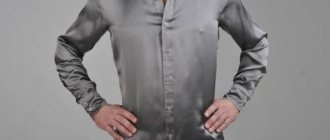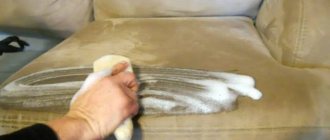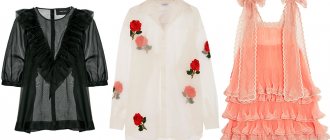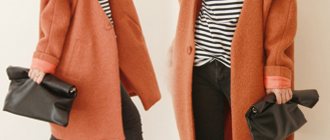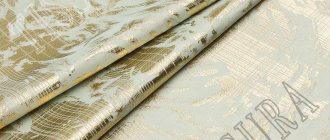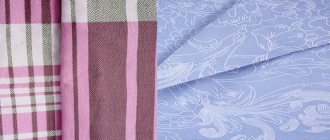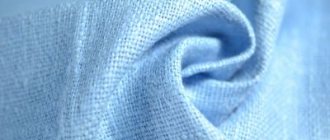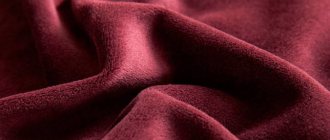Organza fabric is a transparent material that combines fine structure and rigidity. Like many other fabrics, it came to the European continent from the East and quickly became popular. Initially, it was made by hand from natural silk fibers, the process was complex and labor-intensive. Therefore, it was available to few and was used mainly for finishing clothes.
With the advent of synthetic fibers and new technologies, the production of the material has become less expensive, and it has become widely used in the clothing industry and other fields. Let's take a closer look at what kind of organza fabric this is and what its advantage is. This will help many people learn about the advantages of the fabric and its uses.
Composition and characteristics of organza
Industrial production of matter is based on the use of various raw materials:
- natural silk threads, which give the fabric a beautiful glossy shine;
- viscose fibers - soft, perfectly absorbing moisture;
- polymer fiber - a durable synthetic material.
Thanks to the use of the finest threads and a special weaving method, the result is an almost weightless, transparent fabric. Synthetic fibers are pre-treated to create edges on their surface that give the surface a sparkling shine.
Despite its attractive appearance, organza material is highly durable. The combination of the advantages of natural silk and artificial threads provided high characteristics of the mixed fabric, including the following:
- resistance to deformation, does not form folds or creases when compressed;
- high strength, wear resistance;
- transparency, excellent ability to transmit light;
- resistance to organic solvents;
- after washing, the material does not deform and does not shrink;
- Ideal for creating curvy silhouettes.
Features include a not very pleasant, slightly scratchy surface, poor breathability, capriciousness when creating seams and high maintenance requirements.
Which is better: veil or organza?
Voile and organza are very similar in appearance and are used in the same areas. However, these materials are completely different in their properties. The veil is lighter and softer. But it cannot hold its shape as well as rigid organza.
Both fabrics have their advantages and disadvantages, so it is better to choose the material based on the task. For example, if you need to sew curtains, then the veil will allow air and sunlight to pass through, and the organza will reliably hide the interior from prying eyes and will not let in bright rays.
Types of organza
Depending on the production method and the raw materials used, the material comes in two types - with a matte and shiny surface. It can be monochromatic and contain drawings applied in one of the following ways:
- machine embroidery;
- chemical etching;
- printing using equipment.
The most popular types of matter are:
- chameleon - changes color depending on the lighting;
- rainbow – characterized by a smooth transition of various shades;
- with spraying - a beautiful shimmering surface of golden or silver color;
- crash - resembles the appearance of broken glass;
- jacquard - with an ornament made by special twisting of threads;
- pressed - obtained by twisting and pressing, has numerous folds and creases.
To give it an original look, lurex decorations are used, and various ornaments are created using laser perforation.
Given the variety of options, many are interested in what kind of organza devore is this? This unusual variety is obtained by chemical processing, resulting in a beautiful pattern with a three-dimensional appearance on the surface. Drawings on canvases made from different fibers look most impressive. This material is used for interior design and finishing of various outfits.
When asked what linen organza is, you can answer that this fabric was created specifically for summer; it combines the advantages of natural linen and the practicality of synthetics. Clothes made from it are very soft, pleasant and provide a comfortable microclimate in the heat.
Types and their properties
The types of material determine its properties. Silk organza and budget synthetic organza are available on sale. Floral organza is suitable for making flowers. It is characterized by rigidity and richness of colors. Fabric for flowers is available in delicate shades: cream, yellow, peach. Bouquets require pink and red organza.
White organza is considered popular. It is necessary for sewing wedding dresses, curtains, etc. Gold organza is not used independently, but as a decoration. Organza with a pattern is suitable for sewing clothes: blouses, dresses, tunics.
Plain organza is easy to combine and is often used as decoration. Black, green or silver organza will complement a plain crepe, satin or velvet of a similar shade. Also, chameleon organza or mesh is used for finishing materials that are completely different in structure: fur, cotton, corduroy, viscose, gabardine. For sewing skirts, a stiff variety is required. It is placed on elastic or knitwear.
Among other types of material:
- organza devore - fabric with a printed pattern obtained by chemical etching;
- organza with embroidery - an elegant translucent variety for curtains and evening dresses;
- Organza crinkled - or crashed . Suitable for interior decoration, its properties are comparable to smooth varieties;
- matte organza - does not reflect light, looks laconic and is suitable as a curtain for light windows and spacious rooms.
Where is the material used?
| The durable and transparent material is widely used in a wide variety of fields. Perhaps this is one of the most festive fabrics. Delicate holiday dresses, evening dresses are sewn from it, and used for decorative finishing of clothes. It is often used to create dance and masquerade costumes. A separate direction is the production of various accessories and decorative items. Premises for special events are often decorated with miniature trees, bouquets, and bows made of colored fabric. Lovers of “hand made” crafts and professional designers simply adore it; they create real masterpieces - original lampshades, canopies, decorations and covers for furniture. Gift packaging made from this material looks sophisticated and elegant. In interiors, products made from transparent fabric allow many design ideas to be realized; they are used for zoning rooms, adjusting space, and decorating windows. With this design, the interior looks stylish and airy. Thanks to the variety of textures and color palettes, you can choose the most suitable curtain option for your existing style. |
History of fabric
At the end of the 18th century, organza was brought to Europe from the East. The origin of the name is not entirely clear. There are two versions.
- The first samples of fabric were brought from Urgench, an Uzbek city where there was a textile factory. The name of the city changed to “organza”.
- According to another version, the American trademark Logranza produced rigid transparent fabric, which began to be called in accordance with the name of the brand.
Organza should not be confused with organdie, a French fabric made from starched muslin. Organdy was also called an Indian cotton material, similar to organza in its transparency and rigidity. Frills and collars were made from organdy.
Organza decorated in various ways
Organza care
To care for delicate items, it is recommended to follow a few rules:
- When washing in an automatic machine, you should choose a delicate cycle and a temperature no higher than 40 degrees. If the item has embroidery or crystal decorations, it should be washed by hand. In all cases, it is necessary to use a gel, not a powder. Bleaching agents can damage the structure of the threads.
- After washing, the product is gently wrung out by hand and dried flat. Iron wet through a thin fabric, setting the iron to the minimum temperature.
- Before washing and other procedures, it is worth studying the recommendations that are usually present on the label or packaging.
White products can become dull over time and acquire a gray tint, so the pressing question is how to bleach organza at home. Experts recommend the following method. It is necessary to dissolve two tablespoons of table salt in cold water and soak the item in this solution for 8-10 hours. This will help restore not only the snow-white appearance, but also the splendor of the product. But, the ideal option would be to use dry cleaning services.
Preparatory stage
Necessary materials for hemming curtains: sewing machine; needles; threads; scissors; curtain tape; bias tape; meter; knife; candle; pins; iron.
If you decide to hem an organza curtain yourself, you should be prepared for some difficulties due to the properties of the material. Due to its peculiarities, such a curtain requires weighting the bottom edge, only in this case it will lie with even and beautiful folds. So, let's get started.
For all stages of work you will need:
- sewing machine; needles, threads; scissors; curtain braid; bias tape; tailor's cutter; sharp knife; candle or lighter; sewing pins; iron.
Scheme for hemming organza curtains.
Hemming curtains is carried out according to the following scheme.
Measure the width of the window or wall you plan to decorate.
You should not start from the obtained parameters; curtains that lie in large folds look most attractive, which means the width needs to be multiplied by 1.5 or 2. The result obtained is a finished curtain, which means you need to reserve for finishing, and on all sides. After that Once the ideal dimensions of the curtain have been calculated, you can begin cutting. Organza is quite capricious, and it is better to do it on the floor or on a large table.
Mark a cutting line and carefully but confidently cut the material using scissors. Craftswomen share a secret that allows you to make a perfectly even cut. Mark the required length and pull one horizontal thread from the fabric.
This strip will be the best guide when cutting. For cutting, in addition to scissors, you can use a sharp knife heated over an open fire. This method allows you to cut the fabric and finish the edges at the same time. Lay the curtain on a flat surface and press the edge with a tailor's yardstick.
Heat up the knife and cut the fabric in one quick, confident motion. If the metal is hot enough, it will melt the edges during the cutting process and will not allow them to unravel. After this, it is imperative to process the edges, since organza tends to crumble during use. There are two ways to do this.
First, process the cut line using a sewing machine; capricious threads will be held back by a small zigzag or overlock stitch. Second - melt the edge, it is better to perform these manipulations together, one careless movement will ruin the entire canvas. Let an assistant pull the curtain and you walk along the edge with the flame, but it is better to test your dexterity on an inconspicuous area or unnecessary trim.
Sewing work: instructions
Bias tape is applied tape with pre-folded seam allowances.
After the material is cut and the edges are processed, you can proceed directly to the sewing work. If you cut the organza correctly and processed the edges, there should be no difficulties.
The next step is to sew on the bias tape.
It is necessary to select braid and threads that match the tone of the main curtain fabric, then the end result will please you. Using sewing pins, pin the bias tape to the edge of the organza, check the seams again and stitch it on the machine. You can finish the seams without using a special tape. To do this, fold the edge of the curtain twice, about 5-8 mm wide, and carefully stitch it.
This method should be used only if it is not possible to purchase bias tape. Such an edge will look heavy and can spoil the light and airy design of the room. After this, you can proceed to processing the upper part of the curtain. Once again measure the distance from the intended cornice to the floor and add 3-4 cm to the hem.
Lay the organza face down on the table, tuck the material under and pin it with sewing pins. Attach the curtain tape using the same pins and check the quality of the connection. Sew both parts using a sewing machine.
Then tuck in the edges and hand secure them. The bottom edge can be left treated to prevent fraying, but this method will not provide enough weight to make the curtains lay in nice folds. Fold the bottom edge three times, the width of the hem is about 5 mm, and machine stitch it. It is better to use an overlock stitch.
This processing method will ensure sufficient elasticity and weight at the bottom edge. Your curtains are ready. Iron them carefully, making sure that the iron does not overheat; excessive heat will cause the delicate organza to melt. The stylish window frames can now be hung in place.
The proposed method of processing curtains will help you learn how to properly work with such a thin and delicate material as organza. Now you can not only hem the curtains yourself, but also create an exquisite outfit or suit for a child from this magnificent fabric.
- Date: 03/17/2015 Comments: Rating: 45
Organza is a light and airy material that creates an impressive weightless and delicate effect.
This is one of the most successful options for choosing textiles for sewing curtains. You can buy shiny and matte fabric, a natural version made from silk or a synthetic version made from viscose. Any of the selected types of such fabric will be perfect for creating beautiful and modern curtains.
Organza curtains create an airy, weightless, light effect.
There is a misconception that you can sew organza curtains only with a classic cut, that is, ordinary curtains with numerous folds. In fact, this is not so, there are a great many options, you just need to use creativity and a little courage in combining fabrics.
What is canvas
Modern tulle production is distinguished by higher quality, durable weaving and a large assortment of patterns. For loom weaving on an industrial scale, synthetic threads and polyester are used. The fabric acquires some rigidity, but remains transparent and light.
The word "tulle" is masculine. This concept includes any type of light, transparent, daytime curtains. There are organza tulle and veil, which are not much different from each other.
The tulle in most sets is made of organza. Fits organically into any interior, retains its original color for a long time, and its shape with minimal stretching.
Organza veil tulle is less dense and requires gentle use, so it is not intended for window curtains.
